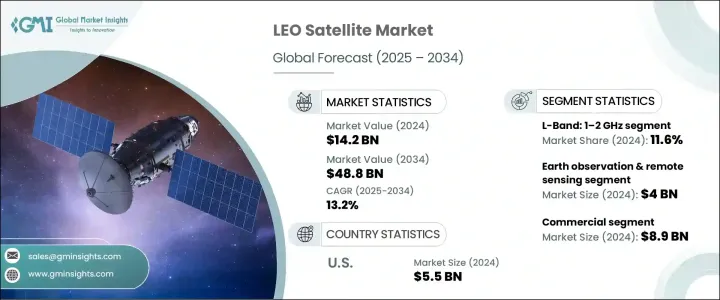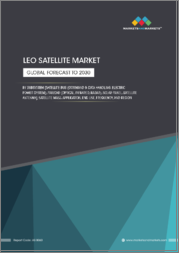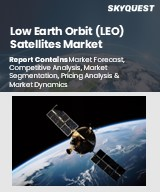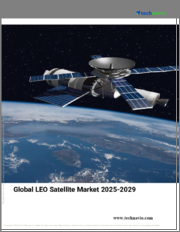
|
시장보고서
상품코드
1755287
세계의 LEO 위성 시장 : 기회, 성장 촉진요인, 산업 동향 분석 및 예측(2025-2034년)LEO Satellite Market Opportunity, Growth Drivers, Industry Trend Analysis, and Forecast 2025 - 2034 |
||||||
세계의 LEO 위성시장은 2024년에는 142억 달러로 평가되었으며, 특히 원격지나 서비스가 미치지 못한 지역에서의 인터넷 접속의 확대라는 세계의 요구에 촉진되어 2034년에는 488억 달러에 이를 것으로 추정되며, CAGR 13.2%로 성장할 전망입니다. LEO 위성은 전통적인 정지궤도 위성보다 훨씬 낮은 고도에서 운영되며, 이는 더 빠른 인터넷 속도와 낮은 지연 시간을 제공하면서 운영 비용을 절감할 수 있습니다. 이러한 시스템은 전통적인 인프라가 부족하거나 경제적으로 실현 불가능한 지역에서 광대역 서비스를 확장하는 핵심 인프라로 자리 잡고 있습니다. 정부 기관과 민간 기업은 농촌, 해상, 신흥 시장 지역에서의 디지털 격차를 해소하기 위해 대규모 LEO 프로젝트를 적극 추진하고 있습니다. 이러한 협력은 더 넓은 커버리지와 더 큰 유연성을 보장하여 포용적인 디지털 액세스에 대한 전 세계의 야망을 지원합니다.

시장은 현대 LEO 위성 군의 필수 구성 요소인 소형 위성의 배포가 증가하고 있습니다. 소형 크기와 비용 효율성으로 진입 장벽이 크게 낮아져 통신, 과학 임무, 지구 관측, 실시간 원격 감지 등의 응용이 가능해졌습니다. 대량 생산과 더 빠른 위성 통합으로의 전환은 새로운 상업 정책과 혁신적인 항공우주 신생 기업에 의해 촉진되어 LEO 시스템의 발사 빈도가 증가하고 있습니다. 종종 조정된 군집으로 배치되는 이러한 소형 위성은 군사, 환경 및 산업 부문에서 신속한 대응 임무를 지원하는 동시에 전 세계적으로 다양한 IoT 기반 데이터 솔루션을 가능하게 합니다.
| 시장 범위 | |
|---|---|
| 시작 연도 | 2024년 |
| 예측 연도 | 2025-2034년 |
| 시작 금액 | 142억 달러 |
| 예측 금액 | 488억 달러 |
| CAGR | 13.2% |
소형 위성 부문은 2023년에 69억 달러의 매출을 올리며 LEO 위성 시장에서 지배적인 위치를 차지했습니다. 이 소형 위성은 지구 관측, 전 세계 통신, 과학 실험, 기술 시연 등 상업용으로 점점 더 많이 사용되고 있습니다. 소형 크기, 짧은 생산 주기, 저렴한 발사 비용으로 더 민첩하고 대응력이 뛰어나며 비용 효율적인 임무를 수행할 수 있게 되어 기존의 우주 모델을 혁신하고 있습니다. 공공 및 민간 부문 업체들은 전 세계 커버리지, 실시간 이미징 및 신속한 데이터 전송을 강화하기 위해 이러한 위성들을 군집으로 배치하고 있습니다.
1-2GHz 대역에서 작동하는 L-밴드 스펙트럼은 2024년에 11.6%의 점유율을 차지했습니다. 대역폭은 제한적이지만, L-밴드는 신호 복원력이 중요한 여러 부문에서 매우 안정적인 통신 서비스를 제공합니다. 두꺼운 구름, 비 또는 기타 대기 장애에서도 작동하는 능력으로 항공 시스템, 해양 통신 및 지상 기반 모바일 서비스에 이상적입니다. 일관된 신호 품질과 낮은 지연 시간으로 이동성 및 방위 관련 위성 통신에서 미션 크리티컬한 애플리케이션의 채택을 촉진합니다.
독일의 LEO 위성 시장은 항공우주 혁신 및 위성 기반 연구에 대한 독일의 강력한 의지에 힘입어 2034년까지 15억 달러 규모로 성장할 것으로 예상됩니다. 유럽 우주국(ESA)과 확고한 협력 관계를 맺고 있는 독일은 지구 관측 임무, 과학 위성 프로젝트 및 기후 중심 프로그램에 기여하고 있습니다. 민간 및 국방 응용 분야를 결합한 이중 용도 우주 자산에 중점을 두고 있는 독일은 공공 및 상업용 위성 개발에서 그 역할을 강화하고 있습니다.
세계의 LEO 위성 시장을 선도하는 주요 기업으로는 Northrop Grumman, Lockheed Martin Corporation, Airbus U.S. Space & Defense, Inc. 및 SpaceX가 있습니다. 이 기업들은 고속 위성 시스템을 개발하고, 발사 능력을 확대하며, 통신 사업자 및 국가 기관과 전략적 파트너십을 구축하여 입지를 다지고 있습니다. 모듈형 위성 아키텍처 및 수직 통합에 대한 투자는 비용 절감과 처리 시간 단축에 도움이 되고 있습니다. 또한, 기업들은 재사용 가능한 발사 기술과 AI 기반 위성 운영을 채택하여 시스템 효율성을 높이고 전 세계 커버리지를 강화함으로써, 확장되는 LEO 위성 미래의 선두에 서기 위해 노력하고 있습니다.
목차
제1장 조사 방법과 범위
제2장 주요 요약
제3장 산업 고찰
- 생태계 분석
- 밸류체인에 영향을 주는 요인
- 이익률 분석
- 혁신
- 장래의 전망
- 제조업자
- 리셀러
- 트럼프 정권의 관세 분석
- 무역에 미치는 영향
- 무역량의 혼란
- 보복 조치
- 산업에 미치는 영향
- 공급측의 영향(원료)
- 주요 원료의 가격 변동
- 공급망 재구성
- 생산 비용에 미치는 영향
- 수요측의 영향(판매가격)
- 최종 시장에의 가격 전달
- 시장 점유율 동향
- 소비자의 반응 패턴
- 공급측의 영향(원료)
- 영향을 받는 주요 기업
- 전략적인 산업 대응
- 공급망 재구성
- 가격 설정 및 제품 전략
- 시책관여
- 전망과 향후 검토 사항
- 무역에 미치는 영향
- 공급자의 상황
- 이익률 분석
- 주요 뉴스와 대처
- 규제 상황
- 영향요인
- 성장 촉진요인
- 전 세계적 연결성 수요 증가
- 소형 위성의 배치 증가
- 발사 비용 절감
- 신속한 지구 관측의 필요성
- 정부 및 국방 투자
- 산업의 잠재적 리스크 및 과제
- 궤도 혼잡 및 파편 위험
- 제한된 위성 수명
- 성장 촉진요인
- 성장 가능성 분석
- Porter's Five Forces 분석
- PESTEL 분석
제4장 경쟁 구도
- 소개
- 기업의 시장 점유율 분석
- 경쟁 포지셔닝 매트릭스
- 전략적 전망 매트릭스
제5장 시장 추정 및 예측 : 위성 유형별(2021-2034년)
- 주요 동향
- 소형 위성
- 펨토 위성(0.01kg 이하)
- 피코 위성(0.01-1Kg)
- 나노 위성(1-10kg)
- 마이크로 위성(10-100kg)
- 미니 위성(100-180kg)
- 중형 위성(180-1,000kg)
- 대형 위성(1,000kg 이상)
제6장 시장 추정 및 예측 : 주파수별(2021-2034년)
- 주요 동향
- L-band : 1-2GHz
- S-band : 2-4GHz
- C-band : 4-8GHz
- X-band : 8-12GHz
- Ku 밴드 : 12-18GHz
- Ka 밴드 : 26-40GHz
- Q/V 밴드 : 33-75GHz
제7장 시장 추정 및 예측 : 용도별(2021-2034년)
- 주요 동향
- 지구 관측 및 원격 감지
- 통신
- 네비게이션과 포지셔닝
- 과학연구
제8장 시장 추정 및 예측 : 최종 용도별(2021-2034년)
- 주요 동향
- 업무용
- 통신
- 운송 및 물류
- 미디어 및 엔터테인먼트
- 기타
- 군 및 방위
- 정부(법 집행 기관과 국토 안보)
- 대학
제9장 시장 추정 및 예측 : 지역별(2021-2034년)
- 주요 동향
- 북미
- 미국
- 캐나다
- 유럽
- 영국
- 독일
- 프랑스
- 이탈리아
- 스페인
- 러시아
- 아시아태평양
- 중국
- 인도
- 일본
- 한국
- 호주
- 라틴아메리카
- 브라질
- 멕시코
- 중동 및 아프리카
- 남아프리카
- 사우디아라비아
- 아랍에미리트(UAE)
제10장 기업 프로파일
- AAC Clyde Space
- Airbus US Space & Defense, Inc.
- Apex
- Blue Canyon Technologies
- GomSpace
- Lockheed Martin Corporation
- NanoAvionics
- Nara Space
- Northrop Grumman
- OHB SE
- Planet Labs PBC
- Rocket Lab USA
- SNC
- SpaceX
- Spire Global
- Surrey Satellite Technology Ltd
- SWISSto12
- Thales
The Global LEO Satellite Market was valued at USD 14.2 billion in 2024 and is estimated to grow at a CAGR of 13.2% to reach USD 48.8 billion by 2034, driven by the global need to expand internet connectivity, especially in remote and underserved regions. LEO satellites operate at much lower altitudes compared to traditional geostationary satellites, allowing them to deliver faster internet speeds and lower latency at reduced operational costs. These systems are becoming the backbone for extending broadband services to areas where traditional infrastructure is limited or economically unfeasible. Both government agencies and private companies are pushing forward large-scale LEO initiatives to bridge the digital divide across rural, maritime, and emerging market regions. These collaborations ensure wider coverage and greater flexibility, supporting global ambitions for inclusive digital access.

The market is witnessing the increasing deployment of small satellites essential components of modern LEO constellations. Their compact size and cost efficiency have significantly lowered entry barriers, enabling applications such as communication, scientific missions, Earth observation, and real-time remote sensing. The shift toward mass production and quicker satellite integration is driven by new commercial policies and innovative aerospace startups, boosting the launch frequency of LEO systems. These small satellites, often deployed in coordinated constellations, help support fast-response missions across military, environmental, and industrial sectors, while enabling a broad array of IoT-driven data solutions worldwide.
| Market Scope | |
|---|---|
| Start Year | 2024 |
| Forecast Year | 2025-2034 |
| Start Value | $14.2 Billion |
| Forecast Value | $48.8 Billion |
| CAGR | 13.2% |
The small satellites segment generated USD 6.9 billion in 2023, reflecting its dominant position in the LEO satellite market. These compact satellites are increasingly used for commercial applications, including Earth observation, global telecommunications, scientific experimentation, and technology demonstrations. Their compact size, shorter production cycles, and lower launch costs have allowed them to disrupt traditional space models by enabling more agile, responsive, and cost-efficient missions. Public and private sector players are deploying constellations of these satellites to enhance global coverage, real-time imaging, and rapid data transmission.
The L-Band spectrum, operating in the 1-2 GHz range, accounted for a 11.6% share in 2024. Though limited in bandwidth, L-Band offers highly reliable service for communication across sectors where signal resilience is crucial. Its ability to perform under heavy cloud cover, rain, or other atmospheric disruptions makes it ideal for aviation systems, marine communication, and land-based mobile services. Its consistent signal quality and low latency drive adoption for mission-critical applications in mobility and defense-related satellite communication.
Germany LEO Satellite Market is projected to reach USD 1.5 billion by 2034, driven by the country's strong commitment to aerospace innovation and satellite-based research. With well-established collaborations with the European Space Agency (ESA), Germany contributes to Earth observation missions, scientific satellite projects, and climate-focused programs. The country's focus on dual-use space assets, combining civilian and defense applications, enhances its role in both public and commercial satellite development.
Top companies leading the Global LEO Satellite Market include Northrop Grumman, Lockheed Martin Corporation, Airbus U.S. Space & Defense, Inc., and SpaceX. These players are securing their foothold by developing high-throughput satellite systems, expanding launch capabilities, and forging strategic partnerships with telecom providers and national agencies. Investments in modular satellite architectures and vertical integration are helping reduce costs and improve turnaround times. Furthermore, companies are adopting reusable launch technologies and AI-driven satellite operations to boost system efficiency and enhance global coverage, ensuring they remain at the forefront of the expanding LEO satellite landscape.
Table of Contents
Chapter 1 Methodology & Scope
- 1.1 Market scope & definitions
- 1.2 Base estimates & calculations
- 1.3 Forecast calculations
- 1.4 Data sources
- 1.4.1 Primary
- 1.4.2 Secondary
- 1.4.2.1 Paid sources
- 1.4.2.2 Public sources
Chapter 2 Executive Summary
- 2.1 Industry synopsis, 2021-2034
Chapter 3 Industry Insights
- 3.1 Industry ecosystem analysis
- 3.1.1 Factor affecting the value chain
- 3.1.2 Profit margin analysis
- 3.1.3 Disruptions
- 3.1.4 Future outlook
- 3.1.5 Manufacturers
- 3.1.6 Distributors
- 3.2 Trump administration tariff analysis
- 3.2.1 Impact on trade
- 3.2.1.1 Trade volume disruptions
- 3.2.1.2 Retaliatory measures
- 3.2.2 Impact on the industry
- 3.2.2.1 Supply-side impact (raw materials)
- 3.2.2.1.1 Price volatility in key materials
- 3.2.2.1.2 Supply chain restructuring
- 3.2.2.1.3 Production cost implications
- 3.2.2.2 Demand-side impact (selling price)
- 3.2.2.2.1 Price transmission to end markets
- 3.2.2.2.2 Market share dynamics
- 3.2.2.2.3 Consumer response patterns
- 3.2.2.1 Supply-side impact (raw materials)
- 3.2.3 Key companies impacted
- 3.2.4 Strategic industry responses
- 3.2.4.1 Supply chain reconfiguration
- 3.2.4.2 Pricing and product strategies
- 3.2.4.3 Policy engagement
- 3.2.5 Outlook and future considerations
- 3.2.1 Impact on trade
- 3.3 Supplier landscape
- 3.4 Profit margin analysis
- 3.5 Key news & initiatives
- 3.6 Regulatory landscape
- 3.7 Impact forces
- 3.7.1 Growth drivers
- 3.7.1.1 Rising demand for global connectivity
- 3.7.1.2 Proliferation of small satellite deployments
- 3.7.1.3 Lower launch costs
- 3.7.1.4 Rapid earth observation needs
- 3.7.1.5 Government and defense investments
- 3.7.2 Industry pitfalls & challenges
- 3.7.2.1 Orbital congestion and debris risk
- 3.7.2.2 Limited satellite lifespan
- 3.7.1 Growth drivers
- 3.8 Growth potential analysis
- 3.9 Porter's analysis
- 3.10 PESTEL analysis
Chapter 4 Competitive Landscape, 2024
- 4.1 Introduction
- 4.2 Company market share analysis
- 4.3 Competitive positioning matrix
- 4.4 Strategic outlook matrix
Chapter 5 Market Estimates & Forecast, By Satellite Type, 2021-2034 (USD Million)
- 5.1 Key trends
- 5.2 Small satellites
- 5.2.1 Femtosatellite (Less than 0.01 Kg)
- 5.2.2 Pico-satellite (0.01-1 Kg)
- 5.2.3 NanoSats (1–10 kg)
- 5.2.4 MicroSats (10–100 kg)
- 5.2.5 MiniSats (100-180 Kg)
- 5.3 Medium satellites (180 - 1000 Kg)
- 5.4 Large satellite (Above 1000 Kg)
Chapter 6 Market Estimates & Forecast, By Frequency, 2021-2034 (USD Million)
- 6.1 Key trends
- 6.2 L-Band: 1–2 GHz
- 6.3 S-Band: 2–4 GHz
- 6.4 C-Band: 4–8 GHz
- 6.5 X-Band: 8–12 GHz
- 6.6 Ku-Band: 12–18 GHz
- 6.7 Ka-Band: 26–40 GHz
- 6.8 Q/V-Band: 33–75 GHz
Chapter 7 Market Estimates & Forecast, By Application, 2021-2034 (USD Million)
- 7.1 Key trends
- 7.2 Earth Observation & remote sensing
- 7.3 Communication
- 7.4 Navigation & positioning
- 7.5 Scientific research
Chapter 8 Market Estimates & Forecast, By End Use, 2021-2034 (USD Million)
- 8.1 Key trends
- 8.2 Commercial
- 8.2.1 Telecommunication
- 8.2.2 Transportation & logistics
- 8.2.3 Media & entertainment
- 8.2.4 Others
- 8.3 Military & defense
- 8.4 Government (law enforcement & homeland security)
- 8.5 Universities
Chapter 9 Market Estimates & Forecast, By Region, 2021-2034 (USD Million)
- 9.1 Key trends
- 9.2 North America
- 9.2.1 U.S.
- 9.2.2 Canada
- 9.3 Europe
- 9.3.1 UK
- 9.3.2 Germany
- 9.3.3 France
- 9.3.4 Italy
- 9.3.5 Spain
- 9.3.6 Russia
- 9.4 Asia Pacific
- 9.4.1 China
- 9.4.2 India
- 9.4.3 Japan
- 9.4.4 South Korea
- 9.4.5 Australia
- 9.5 Latin America
- 9.5.1 Brazil
- 9.5.2 Mexico
- 9.6 MEA
- 9.6.1 South Africa
- 9.6.2 Saudi Arabia
- 9.6.3 UAE
Chapter 10 Company Profiles
- 10.1 AAC Clyde Space
- 10.2 Airbus U.S. Space & Defense, Inc.
- 10.3 Apex
- 10.4 Blue Canyon Technologies
- 10.5 GomSpace
- 10.6 Lockheed Martin Corporation
- 10.7 NanoAvionics
- 10.8 Nara Space
- 10.9 Northrop Grumman
- 10.10 OHB SE
- 10.11 Planet Labs PBC
- 10.12 Rocket Lab USA
- 10.13 SNC
- 10.14 SpaceX
- 10.15 Spire Global
- 10.16 Surrey Satellite Technology Ltd
- 10.17 SWISSto12
- 10.18 Thales



















